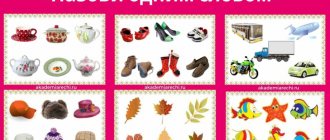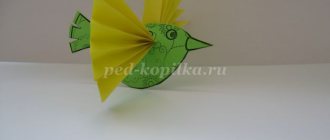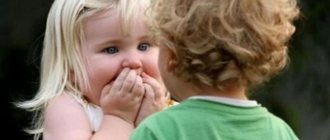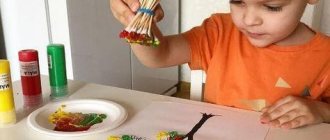Features of vocabulary formation in preschoolers
After listening to a preschooler, you can very quickly determine how rich his vocabulary is, and how the child’s grammatical structure of speech is formed. Each age period corresponds to a certain speech level. A child’s achievements depend on how much attention parents and educators pay to this issue.
Approaching preschool age - by the age of 3 - the child knows most of the words that adults address to him. The baby does not pronounce all of them, but he understands what is being said to him.
Basically, this is still a passive dictionary. But gradually the child masters pronunciation and uses, albeit in a peculiar sound, word after word in his speech.
The formation of vocabulary in preschool children occurs somewhat differently than in schoolchildren. Older children add new concepts to their vocabulary, which they already have quite solid. Preschoolers have yet to reach this level.
First, they need to comprehend words at different levels of generalization. Try telling a 3-year-old child, pointing to his doll or little car: “What a beautiful toy you have!” And the baby will definitely correct you: “This is a doll (car)!”
For a younger preschooler, each word acts as the name of its own separate object or phenomenon. He still doesn’t understand how a doll can be called a toy. And all because the peculiarities of vocabulary formation in preschool age consist in the consistent acquisition of the meaning of the words used.
Stages of mastering the semantic content of a word
The issue of a child’s consistent comprehension of words is very well covered by Doctor of Medical Sciences, Professor of the Academy of Education M.M. Koltsovaya. Let's take a brief look at what levels of verbal generalization a preschooler will have to overcome.
- The child understands the word as referring to a specific object known to him. A cup is the name of that convenient item from which the baby drinks milk and juice. The bunny is that soft pink lump that sits next to the doll. Boots are what you put on your baby's feet. There are no other cups, bunnies or shoes for a child, since a strong connection has been established between the child and specific objects. This is the stage of early comprehension of a word, lasting up to about 1.5 years, and even longer in the perception of new words.
- The meaning of the word becomes broader. The child already understands that other people eat with spoons, not just him. There are many cars, apples are different, and other children and even adults may have shoes. That is, the word already denotes a group of objects. This level of comprehension is available to a 2-year-old child if speech development corresponds to the norm.
- A qualitative breakthrough occurs after 3 years and is manifested in the fact that the preschooler begins to combine some accessible concepts into more general groups. Mom calls a tasty apple, pear and orange fruit, and the child gradually remembers this new concept. Further comprehension tells the child that banana can also be included in this list. The preschooler already calls all his play objects toys. At this stage there is no end to the work. We need to comprehend new categories: furniture, transport, clothing, pets, wild animals...
- A preschooler begins to perceive generalized concepts that include several smaller groups (plants, things, natural phenomena, etc.) only from the age of 5. Understanding the semantic meaning of such general concepts requires logical thinking. A high degree of generalization is too distant from real sensations, and systematic work is required for a preschooler to include general concepts in his vocabulary.
The statements of some developed children under 5 years of age may sometimes contain general concepts: “My things,” “We saw a beautiful plant.” But it is enough to ask a preschooler a few questions and it becomes obvious that he uses these words in a narrow sense.
Types of vocabulary in the development of preschool children
Work on the word, the initial unit of language, occupies one of the most important places in the overall system of work on speech development.
Work on the formation of vocabulary in preschoolers is considered as “a purposeful pedagogical activity that ensures the effective development of the vocabulary of the native language.”
The development of children's vocabulary is understood as a long process of quantitative accumulation of words, mastering their socially assigned meanings and developing the ability to use them in specific communication conditions.
The word provides the content of communication. Fluent oral and written speech relies, first of all, on having a sufficient vocabulary.
Language, as a means of communication, is, first of all, the language of words. Words call specific objects, abstract concepts, express feelings and relationships.
Vocabulary work in kindergarten is the systematic expansion of children’s active vocabulary using words that are unfamiliar or difficult for them. It is known that the expansion of the vocabulary of preschoolers occurs simultaneously with their familiarization with the surrounding reality, with the development of a correct attitude towards the environment.
The process of children learning the meanings of words and their semantics was studied by L.S. Vygotsky, who established that a child, as he develops, moves from random, unimportant signs to essential ones. As age changes, the completeness and correctness of his reflection in his speech of facts, signs or connections that exist in reality change.
Features of the development of thinking largely determine the features of a child's vocabulary. Visually - effective and visually - imaginative thinking explains the predominance of words denoting the names of objects, phenomena, qualities. The emergence of verbal and logical thinking causes children to master elementary concepts.
The method of speech development considers such an important issue as the concept of active and passive vocabulary.
Active vocabulary is words that the speaker not only understands, but also uses (more or less often). An active vocabulary largely determines the richness and culture of speech.
Passive vocabulary is words that a speaker of a given language understands, but does not use himself. The passive vocabulary is much larger than the active one; this includes words whose meaning a person guesses from the context, which emerge in consciousness only when he hears them. The formation of children's vocabulary is considered in two aspects.
The first aspect is the child’s mastery of the subject-matter of words and their conceptual content. It is associated with the development of children's cognitive activity. In preschool methods of speech development, this aspect was developed, first of all, in the works of E.I. Tikheyeva, M.M. Konina, L.A. Penevskaya, V.I. Loginova, V.V. Gerbova, A.P. Ivanenko, V.I. Yashina.
The second aspect is the assimilation of the word as a unit of the lexical system, its connections with other lexical units. Here, familiarizing children with polysemantic words, revealing their semantics, and using antonyms, synonyms, and polysemantic words accurately in meaning, is of particular importance, i.e. development of the semantic side of speech. This direction is largely represented in the works of F.A. Sokhin and his students (O.S. Ushakova, E.M. Strunina and others). Both of these aspects are interconnected, and, of course, work on the semantic side of the word becomes possible only when children master the objective, conceptual content of the word.
In the domestic methodology for speech development, the tasks of vocabulary work in kindergarten were defined in the works of E.I. Tikheyeva, O.I. Solovyova, M.M. Horsemeat and refined in subsequent years. Today it is customary to identify four main tasks:
- Enriching the vocabulary, i.e. assimilation of new words previously unknown to the child, as well as new meanings of a number of words already in their vocabulary. The enrichment of the dictionary occurs, first of all, due to commonly used vocabulary (names of objects, features and qualities, actions, processes, etc.).
- Clarification of the dictionary, i.e. vocabulary and stylistic work. Mastering the accuracy and expressiveness of language (filling with content words known to children, mastering polysemy, synonyms, etc.). This task is due to the fact that in children the word is not always connected with the idea of the object. They often do not know the exact names of objects, so work is required to deepen children’s understanding of already known words, fill them with specific content based on an exact correlation with objects in the real world, further mastery of the generalization that is expressed in them, and develop the ability to use commonly used words
Activation of the dictionary, i.e. transferring as many words as possible from the passive to the active dictionary, including words in sentences and phrases;
- Elimination of non-literary words, their translation into a passive dictionary (colloquial, dialect, slang). This is especially necessary when children are in a disadvantaged language environment.
Active and passive vocabulary of a preschooler
In the stock of words already known to the child, there are active and passive vocabulary. A baby may respond correctly to a certain word, but not even try to pronounce it. In this case, the word is a passive. For example, a child understands and responds to the instruction “Take,” but until middle preschool age this word is unlikely to appear in his speech. Moreover, there is such a simple and understandable “Here!”
A 3-year-old vocabulary should ideally include 1-1.5 thousand words, and it already includes all parts of speech. But only some of them are actively used by the child.
Active vocabulary involves mastering the meaning of words and applying them to their place and logical connection.
During the preschool years, a child's vocabulary at least triples. The active vocabulary should use most of this stock. That is, the preschooler uses in everyday life the predominant number of words that he knows.
Replenishing a child’s vocabulary with different types of parts of speech
Between one and three years of age, a child remembers the following:
- what are the names of your loved ones;
- what are the toys called?
- how household items are designated (food, dishes, hygiene items, etc.)
- natural phenomena;
- Seasons;
- easy names of plants and animals
A child’s vocabulary at this age has not yet been replenished with words that allow him to clearly express his assessment or emotions.
By the age of four or five, a child’s speech is already filled with a larger volume of words; he operates in a completely different way with concepts that have already been learned. What does a preschooler remember at this time:
- Labeling feelings (sad, happy, angry, etc.)
- Qualitative characteristics of objects (low, cold, light, etc.)
- How to correctly create a diminutive form of the word (son, daddy)
- Cognate words: (rook-rook; cat-kitten-cat)
By the age of five or six, a preschooler, as a rule, has already mastered about three thousand or more words; he knows the following:
- Time designation - days, weeks, hours, minutes, etc.
- Designation of space - right, left, sideways, etc.
- Simple and complex numbers
- The name of peoples, countries, the designation of social phenomena - labor, state, etc.
The child increases his stock of verbs and nouns most quickly, and adjectives more slowly. Since it is this part of speech that gives imagery to the conversation and saturates it, adults should pay attention to the descriptive and qualitative characteristics of objects and phenomena.
Enriching the vocabulary of preschoolers
Based on the presented description of the stages of understanding concepts, it follows that the development of the vocabulary of children of primary preschool age occurs due to the frequent use of the same words and the addition of new ones. All parents teach their children to name objects and actions.
To help a child comprehend words as a second-level generalization, one must be given the opportunity to touch objects and act with them. It is important to establish as many conditional connections as possible. It is necessary to encourage action: take it, give it to me, turn it, open it, close it, etc. At the same time, you should say a new word repeatedly. For example, “take the pencil case”, “open the pencil case”, “what do you want to put in the pencil case?” This is how the word turns into a meaningful concept and is fixed in the memory of the preschooler.
It is necessary to move to the next level of generalization already in early preschool age. When spending time with your child, it is important to use any environment to increase his awareness.
For example, when pointing to a trolleybus, you need to note not only its “horns”, but also call it the general concept of transport. Immediately give an example of another type of transport and repeat it with your child. And practice this way with each group of concepts.
The development of the vocabulary of preschool children occurs through common and easily implemented methods:
- mastering new concepts
- consolidation of generalizing words
- use of associative series
If you stop using the word as a generalization, then very soon the preschooler will narrow its meaning. For example, a sofa will be considered furniture, while tables and chairs will remain apart; He will classify the usual cucumber and tomato as vegetables, but will forget about onions and beets.
The use of associative connections fills a child’s vocabulary well. “What kind of car do you have?” - and the preschooler begins to describe: “Beautiful, new, goes fast, with a body, blue...”. The more characteristics of any concept adults list, the more words will appear in the child’s descriptive speech.
Don't lose sight of your preschooler's verb vocabulary. It is harmful to perform actions in the presence of a child in silence! There is nothing difficult about talking through each step. Mom can silently lay out the cutlery and only say: “Now we’ll eat.” But nothing prevents you from voicing the whole process: “Let’s put a plate, pour some soup into the plate, put a spoon next to it, and now we’ll sit down to eat.” These methods are extremely simple, but very effective for speech development at 3-4 years old.
It seems to adults that these are completely ordinary words that the child will sooner or later master. And for a child, this is necessary material for replenishing his active vocabulary.
Techniques for developing vocabulary for older preschool children
As the child grows up, it is necessary to complicate and increase the verbal load. It is necessary to use new concepts more and more in speech, explain their meaning to children, and after some time ask about the meaning of new words. It is also important to complicate the content and form of the sentence, showing the preschooler an example of the use of words in speech.
6-year-old children should have a vocabulary of more than 3,000 words. At this age, the preschooler comprehends concepts related to time periods and spatial orientation, and is interested in abstract concepts.
Ways to develop the vocabulary of an older preschooler:
- Ask the child to explain how he understands the meaning of the word. In such explanations, children rely on the functional characteristics of the object and better remember new concepts (jump rope - a rope that they jump over; a meat grinder - chops meat into small pieces, etc.)
- Look for connections with already known concepts and classify them as a general group (turkey is a bird, a domestic animal)
- Introduce the preschooler to different meanings of words (homonymous series: braid, brush, ring, car, bow, etc.)
- Form comparative degrees of adjectives (tall - higher, beautiful - more beautiful, good - better)
- Pay attention to new words when reading fairy tales and other children's literature: explain the meaning, offer to repeat the word.
At preschool age, the core of the vocabulary is formed, which is also used by adults. If you miss this sensitive period, it will not be easy to catch up in the child’s speech development. People don't just speak with words. They think and reflect with their help. Expanding a preschooler's vocabulary means not only increasing his awareness, but also developing his thinking.
Methods and techniques for developing vocabulary in preschool children
There are two groups of methods:
— methods of accumulating the content of children's speech;
- methods aimed at consolidating and activating the vocabulary, developing its semantic side.
The first group includes methods:
* direct acquaintance with the environment and enrichment of vocabulary: examination and examination of objects, observation, inspections of the kindergarten premises, targeted walks and excursions;
* indirect acquaintance with the environment and enrichment of vocabulary: viewing paintings with unfamiliar content, reading works of art, showing films and videos, watching television programs.
The second group of methods is used to consolidate and activate vocabulary: looking at toys, looking at pictures with familiar content, didactic games and exercises.
Didactic games are educational, cognitive games designed to expand, deepen and systematize children’s ideas about the environment, to cultivate cognitive interests and develop cognitive abilities.
Didactic games are a widespread method of vocabulary work. Play is one of the means of mental education. In it, the child reflects the surrounding reality, reveals his knowledge, and shares it with friends. Certain types of games have different effects on children's development.
A particularly important place in mental education is occupied by didactic games, the obligatory elements of which are cognitive content and a mental task. By repeatedly participating in the game, the child firmly assimilates the knowledge with which he operates.
Solving a mental problem in a game, the child practices voluntary memorization and reproduction, classifying objects or phenomena according to general characteristics, identifying the properties and qualities of objects, and identifying them according to individual characteristics.
In didactic games, children are given certain tasks, the solution of which requires concentration, attention, mental effort, the ability to comprehend the rules, sequence of actions, and overcome difficulties. They promote the development of sensations and perceptions in children, the formation of ideas, and the acquisition of knowledge.
These games make it possible to teach children a variety of economical and rational ways to solve certain mental and practical problems. This is their developing role.
It is necessary to ensure that didactic play is not only a form of assimilation of individual knowledge and skills, but also contributes to the overall development of the child and serves to shape his abilities. Each didactic game has its own program content, which includes a certain group of words that children must learn.
In preschool pedagogy, all didactic games can be divided into three main types:
- games with objects (toys, natural materials),
— desktop-printed;
- word games.
Games with objects:
Playing with objects uses toys and real objects. By playing with them, children learn to compare, establish similarities and differences between objects. The value of these games is that with their help children become familiar with the properties of objects and their characteristics: color, size, shape, quality.
The games solve problems involving comparison, classification, and establishing sequence in solving problems. As children master new knowledge, the tasks in games become more complex: preschoolers practice identifying an object by any one quality, combining objects according to this characteristic (color, shape, quality, purpose, etc.), which is very important for the development of abstract, logical thinking .
While playing, children acquire the ability to put together a whole from parts, string objects (balls, beads), and lay out patterns from various shapes.
By playing with dolls, children develop cultural and hygienic skills and moral qualities. A variety of toys are widely used in educational games. They clearly express color, shape, purpose, size, and the material from which they are made.
In games, knowledge is improved about the material from which toys are made, about the objects that people need in various types of their activities, which children reflect in their games.
The teacher uses games with natural materials (plant seeds, leaves, various flowers, pebbles, shells) when conducting such didactic games as “Whose children are these?”, “Which tree is the leaf from?”, “Who is most likely to lay out a pattern from different leaves? " The teacher organizes them during a walk, directly in contact with nature: trees, shrubs, flowers, seeds, leaves. In such games, children’s knowledge about the natural environment around them is consolidated, mental processes are formed (analysis, synthesis, classification) and a love for nature and a caring attitude toward it are fostered.







